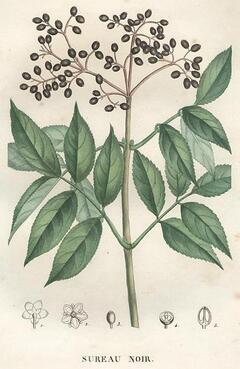Elderberry - Sambucus Nigra
Picture source: http://botanical.com/botanical/mgmh/e/elder-04.html
Physical Characteristics
“The ELDERBERRY is a deciduous shrub or small tree growing up to 6 metres tall and wide. Yet another very easily grown plant, it tolerates most soils and situations, growing well on chalk and in heavy clay soils. It tolerates some shade but fruits better in a sunny position. It also tolerates atmospheric pollution and coastal situations. The small white flowers are produced in large racemes in late spring and early summer. They make a delicious refreshing snack on a hot day, though you have to be a bit careful when eating them because they are very attractive to a wide range of insects and you could end up eating more than you had bargained for. The flowers can also be used to add a muscatel flavour to stewed fruits, jellies and jams, and are often used to make a sparkling wine.” http://www.pfaf.org/leaflets/flowers.php
“The word 'Elder' comes from the Anglo-Saxon word aeld. In Anglo-Saxon days we find the tree called Eldrun, which becomes Hyldor and Hyllantree in the fourteenth century. One of its names in modern German - Hollunder - is clearly derived from the same origin. In Low-Saxon, the name appears as Ellhorn. Æld meant 'fire,' the hollow stems of the young branches having been used for blowing up a fire: the soft pith pushes out easily and the tubes thus formed were used as pipes - hence it was often called Pipe-Tree, or Bore-tree and Bour-tree, the latter name remaining in Scotland and being traceable to the Anglo-Saxon form, Burtre.
The generic name Sambucus occurs in the writings of Pliny and other ancient writers and is evidently adapted from the Greek word Sambuca, the Sackbut, an ancient musical instrument in much use among the Romans, in the construction of which, it is surmised, the wood of this tree, on account of its hardness, was used. The difficulty, however, of accepting this is that the Sambuca was a stringed instrument, while anything made from the Elder would doubtless be a wind instrument, something of the nature of a Pan-pipe or flute. Pliny records the belief held by country folk that the shrillest pipes and the most sonorous horns were made of Elder trees which were grown out of reach of the sound of cock-crow. At the present day, Italian peasants construct a simple pipe, which they call sampogna, from the branches of this plant. ” http://botanical.com/botanical/mgmh/e/elder-04.html
Edible Uses
Edible Parts: flowers, berries
“Fruit - raw or cooked. The flavour of the raw fruit is not acceptable to many tastes, though when cooked it makes delicious jams, preserves, pies and so forth. It can be used fresh or dried, the dried fruit being less bitter. The fruit is used to add flavour and colour to preserves, jams, pies, sauces, chutneys etc, it is also often used to make wine. The fruit is about 8mm in diameter and is borne in large clusters. Some caution is advised, see the notes above on toxicity. Flowers - raw or cooked. They can also be dried for later use. The flowers are crisp and somewhat juicy, they have an aromatic smell and flavour and are delicious raw as a refreshing snack on a summers day, though look out for the insects. The flowers are used to add a muscatel flavour to stewed fruits, jellies and jams (especially gooseberry jam). They are often used to make a sparkling wine. A sweet tea is made from the dried flowers. The leaves are used to impart a green colouring to oils and fats.” http://www.pfaf.org/database/plants.php?Sambucus+nigra
Elderberry Crunch Bread -http://www.care2.com/greenliving/elderberry-crunch-bread.html
More recipes such as: Elder Wine/Elderberry Jam without Apples/Elderflower Vinegar/Elderberry Chutney, you can fined here:
http://botanical.com/botanical/mgmh/e/elder-04.html#rec
http://www.istrianet.org/istria/gastronomy/osteria/condiments-elderberry1.htm
Medicinal Uses
http://botanical.com/botanical/mgmh/e/elder-04.html#med
http://www.pfaf.org/database/plants.php?Sambucus+nigra
Myths and Tales
“In Denmark we come across the old belief that he who stood under an Elder tree on Midsummer Eve would see the King of Fairyland ride by, attended by all his retinue. Folkard, in Plant-Lore, Legends and Lyrics, relates:'The pith of the branches when cut in round, flat shapes, is dipped in oil, lighted, and then put to float in a glass of water; its light on Christmas Eve is thought to reveal to the owner all the witches and sorcerers in the neighbourhood', and again: 'On Bertha Night (6th January), the devil goes about with special virulence. As a safeguard, persons are recommended to make a magic circle, in the centre of which they should stand, with Elderberries gathered on St. John's night. By doing this, the mystic Fern-seed may be obtained, which possesses the strength of thirty or forty men.
In some of the rural Midlands, it is believed that if a child is chastised with an Elder switch, it will cease to grow, owing, in this instance, to some supposed malign influence of the tree. On the other hand, Lord Bacon commended the rubbing of warts with a green Elder stick and then burying the stick to rot in the mud, and for erysipelas, it was recommended to wear about the neck an amulet made of Elder 'on which the sun had never shined.'
And Canon Ellacombe says that in the Tyrol: 'An Elder bush, trimmed into the form of a cross, is planted on a new-made grave, and if it blossoms, the soul of the person Iying beneath it is happy.'
Green Elder branches were also buried in a grave to protect the dead from witches and evil spirits, and in some parts it was a custom for the driver of the hearse to carry a whip made of Elder wood.”
source: http://botanical.com/botanical/mgmh/e/elder-04.html
see also: Brussels Plants

